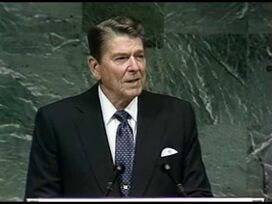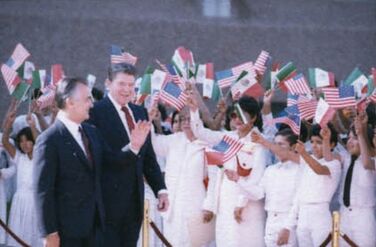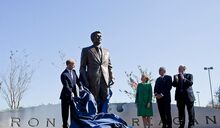|
| |
| Predecessor | Jimmy Carter |
| Successor | George Bush |
| Born | February 6, 1911 Tampico, Illinois, U.S. |
| Died | May 8, 1984 (presumed, aged 73) South Pacific off course en route to Hawaii |
| Spouse | Nancy Reagan (d. May 8, 1984 - presumed) |
| Political Party | Republican |
Ronald Wilson Reagan (February 6, 1911 - approx. May 8, 1984) was the 40th President of the United States. He was the President on Doomsday and was the one to make the decision to launch a nuclear counterstrike.
Although Reagan survived for the next six months, they would prove to be a painfully difficult time as Reagan worked around the clock to reorganize the remnants of the US government and ensure the survival of as many Americans as possible. It was eventually decided that in order to accomplish this, the federal government would need to relocate from the U.S. mainland to Hawaii, where it could enlist the help of the most powerful US allies left in the world, New Zealand and Australia.
In May of 1984, Reagan and the rest of his administration attempted to travel to Hawaii to make this happen. However, Air Force One crashed in the South Pacific during the evacuation. No wreckage nor trace of him, his family, or of his staff have been found to this day; thus making it one of the most eerie mysteries in aviation history.
Early Years[]
Ronald Wilson Reagan was born on February 6, 1911 in Tampico, Illinois. The Reagan family frequently moved around various small towns in Illinois during Ronald's youth. He moved to California in 1937 to pursue an acting career. His political activities began in 1947 when he began his first of two periods as president of the Screen Actors Guild. He got involved in Republican Party politics in 1964 when he campaigned for Barry Goldwater. Two years later he campaigned on his own behalf for the first time, winning the election for governor of California.
Reagan won the 1980 U.S. Presidential election and was inaugurated on January 20, 1981. He was a staunch anti-communist, denouncing the Soviet Union, the Iron Curtain, and the human rights abuses of the Eastern Bloc, which he referred to as the "Evil Empire".
Doomsday[]

President Reagan at the UN.
President Reagan and his wife Nancy were in New York to attend a session of the United Nations, where Reagan was scheduled to speak the following day. At the moment when the missiles were detected, he was in the Hilton Room of the Waldorf Astoria, the "Manhattan White House" that served as the center of Presidential activity in the city. He was attending a reception for members of the American delegation to the UN. Others present included his wife, Secretary of State George Shultz, and New York mayor Ed Koch. The president had just concluded a speech, the ironic words of which have been preserved:
"I've come to New York this year because I want to reaffirm that the United States of America will continue to work constructively in the United Nations and in every other forum to help resolve conflicts, to support the forces of peace and international civility, and to promote economic cooperation and prosperity. We believe arms reductions are of particular importance. The commitment of the United States to the goals of the U.N. Charter is unwavering. In the cause of peace, my country will play its part and carry its share of the burden."
Reagan was mingling with other guests after his speech when a member of his Secret Service detail frantically grabbed his arm and began hurriedly escorting them to the door. As they hurried towards the exit, the agents informed Reagan that a massive Soviet attack was underway.
As Reagan made his way to the roof, another agent opened the Nuclear Football - the black case containing the codes and procedures that would activate America's response in such a situation. Stunned by the import of what was happening, Reagan gave the orders to activate the Emergency Alert System and launch a full nuclear counterstrike against the Soviet Union.
In the corridor, Reagan stopped to inform Koch and urged him to join him aboard Air Force One. Koch declined the President's offer, saying "There's no role for me without my city. There's still a role for you, the country will need you more than ever."

A photo taken by one of Reagan's staff as the President and Mrs. Reagan arrive by helicopter at LaGuardia Airport in Queens NYC to board Air Force One on Doomsday.
Marine One took the Reagans, Shultz, and their detail to LaGuardia Airport, from which Air Force One and its escort of fighter jets lifted off from the Big Apple for the last time and began maneuvering to avoid being targeted. Reagan spoke on a special hotline with the Vice President, currently being evacuated from Washington, DC, and with General James V. Hartinger, the commanding officer of NORAD in the Cheyenne Mountain Complex.
Key government and military personnel around the country initiated evacuation procedures. Ground forces in the continental US attempted to leave their doomed bases as quickly as possible to help maintain order in their respective regions once the dust had settled. Reagan knew that this would not be possible in many cases, but that the effort had to made. Members of Reagan's cabinet were taken via helicopter to two relocation sites in the Appalachian Mountains, Mount Weather in Virginia and Greenbrier in West Virginia.

The above-ground portion of the Mount Weather Emergency Operations Center, where Reagan and his team would live until spring 1984.
As Air Force One approached its destination, Reagan next called Mexican President Miguel De la Madrid. Reagan told De la Madrid that there would very likely be a large influx of American refugees into his country in the coming months, and he asked the Mexican leader to accept them. In exchange, Reagan would send a communique to US Army units on the border and order them to assist the Mexican Army in maintaining order in any US refugee camps. De la Madrid accepted Reagan's offer and wished him well.
Reagan arrived at Mount Weather and was quickly escorted underground to its emergency command center. Most of his Cabinet members had already arrived, some with their families, others without, and were seated in the facility's Situation Room.
Years later, one of Reagan's surviving staff members would tell the Australian press corps: "I had seen a copy of the speech President Reagan had been planning to give at the UN. In perhaps one of the greatest ironies of history, in that speech he was supposed to give on September 26, 1983 President Reagan had been planning to urge the world to work to avoid a nuclear war and was going to call for stronger arms control agreements. I will never forget one particular line. He was going to say that "A nuclear war cannot be won, and it must never be fought."
President Reagan was right," remarked the staff member. "We all lost on Doomsday."
Laying the Groundwork to Rebuild America[]

President Reagan broadcasting on an emergency channel from Mount Weather to the Cheyenne Mountain Complex, after communications were reestablished, to discuss the ongoing Continuity of Government plans with General Hartinger.
The Day After[]
On the morning of September 26, 1983, President Reagan and his staff at Mt. Weather morosely watched and listened as the computers in reports that contact had been lost with almost all of the country. What little information could be gathered indicated widespread and catastrophic devastation across the homeland. Reagan, exhausted from going without sleep and heartbroken, ordered the military to continue their attempts to regain contact with as many civil and military officials as possible.
Evacuation[]
In spring 1984, when communication with NORAD were restored, President Reagan enacted a plan to divide his administration, relocating to secure sites that would serve as bases to restabilize the continent. Bush would lead an administration from Colorado, where he would collaborate closely with General Hartinger and Governor Edgar Herschler of Wyoming. Reagan himself would travel to Hawaii. There, he could solidify the government's control over its Pacific territories, take command of the ongoing defense of Alaska, and work closely with the ANZUS allies. Reagan hoped that he would be able to secure funds and military forces to help the surviving elements of the US military reassert control over the crumbling homeland.
Charleston and Mexico[]

Reagan boards Air Force One in Charleston for the trip to Mexico.
Reagan boarded Air Force One in the hangar at Mt. Weather with his staff in early May 1984. Secretary of State George Shultz recalls that Reagan "looked visibly despondent over the failure to secure the Relocation Arc, but also grimly determined. In our Cabinet meetings at Mt. Weather, we'd come to the conclusion that the most likely place to restore our nation was in the Pacific. The President hated having to leave in this time of devastation, but we'd all agreed that we needed to relocate - and of course the help of the Australians and the Kiwis."
Before heading off to establish their separate administrations, Reagan went to Charleston, West Virginia, with Bush and Strom Thurmond. Bush was to lead the administration in the Rocky Mountains near Cheyenne Mountain, while Thurmond, President Pro Tem of the Senate and 3rd in line for the presidency, would stay behind in the city - the last surviving state capital in the region - to serve as titular leader of the administration. Both Bush and Thurmond had taken refuge in the Greenbrier site and were seeing Reagan for the first time since the attacks. For a few days starting April 23, they met both privately and publicly, making plans for the divided administration while trying to reassure people that the nation would endure.

The final photo taken of President Ronald Reagan, meeting Mexican President De la Madrid with a welcoming delegation upon his arrival in Mexico City.
On May 3, Air Force One left Charleston and arrived at an airfield outside Mexico City, where Reagan, Shultz, and other members of the Pacific administration were greeted by Mexican President Miguel De la Madrid and a welcoming party of Mexican schoolchildren waving Mexican and American flags as a gesture of friendship. Reagan also was able to meet with his vice president's family: his son George, daughter-in-law Laura, and granddaughters Barbara and Jenna, who had evacuated to Mexico and were waiting at the landing zone to see the President taling with a few other American refugees. In the brief remarks Reagan gave at the airport, he commented, "The sight of the warm welcome given to us by you, the Mexican people, and the sight of so many of my fellow-countrymen, including the family of my friend George Bush, is overwhelming. It gives me hope for the future, and we need that hope. Let us work together to keep that hope going, and may it sustain us in our works here today and beyond."
Lost over the Pacific[]

President Reagan discusses operations with the Air Force One flight crew during the journey to Mexico.
When Reagan left for Hawaii, he planned to eventually return to the American mainland. He anticipated that his stay in the Pacific would be a temporary one, though he planned for Secretary Shultz to remain in the region for a longer period of time to negotiate continued support for the war and reclamation effort. In President Reagan's last communication to General Hartinger, he estimated that he would return to America in early 1985, with the surviving remnants of the US Pacific Fleet and the Australian military, to join forces to restore order in the western part of the country. Reagan also hoped that upon his return, he could secure cooperation from Mexican border troops to assist in this venture.
Sadly, Reagan would not live to carry out this plan. Shultz, in a second plane with his cabinet colleagues Malcolm Baldridge and Liddy Dole, landed safely in Hilo on May 7. But Air Force One experienced mechanical problems; the last recorded message from the pilot reported extreme duress over the Pacific Ocean. Both Hilo and the RAAF lost contact with the plane, and it was lost along with the President, First Lady, Agriculture Secretary John Block, and numerous other federal personnel.
In later years, General Hartinger (now retired) expressed the belief that if Reagan or Bush, or both, had remained in the Rockies with the entire Cabinet and associated personnel, then they could have better maintained the coherence of the administration. This would have been at the cost of Alaska, which was trying on its own to repel a Soviet invasion, and the cost of aid from Australia and New Zealand. As it was, both administrations ultimately failed. Bush decided to carry out Reagan's original plan and run the country from the Pacific, but after a decade of effort the American Provisional Administration disbanded in 1995. The administration in Colorado was crippled by the assassination of Bush's successor, former Speaker of the House Tip O'Neill, in 1986. His successors did not formally disband the administration but became increasingly dependent on the State of Wyoming. History buffs in the USA have produced alternate history stories about how differently things might have gone had the administration remained in one piece in the Rockies.
Legacy[]

The unveiling of the Ronald Reagan Memorial in Torrington, DK
In Torrington, capital of the Provisional (and then restored) United States since 1991, President Reagan is remembered for his efforts to preserve the United States following the nuclear cataclysm. There is a monument to him on the New National Mall, Torrington.
The Soviet-aligned nations and their sympathizers tend to have decidedly more negative views of President Reagan. They blame him for Doomsday, accusing him of launching a surprise attack, while American and Allied survivor nations tend to place the blame at Yuri Andropov's feet. Meanwhile, Reagan's efforts to defend the United States have ensured that he is remembered warmly as a pivotal figure in the United States, and his reputation there remains largely positive, albeit tinged with tragedy as "the President who had to face Doomsday."
Sources[]
- Reagan, Ronald (25 September 1983). Remarks at a Reception for the Heads of Delegation to the 38th Session of the United Nations General Assembly in New York, New York. Ronald Reagan Presidential Library & Museum. [1]
- White House (25 September 1983). The Daily Diary of President Ronald Reagan. Ronald Reagan Presidential Foundation & Institute. [2]

